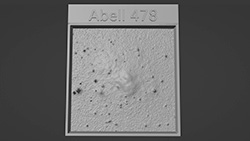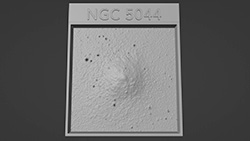CXC Home | Search | Help | Image Use Policy | Latest Images | Privacy | Accessibility | Glossary | Q&A
1
X-ray, Radio, Optical, & Infrared Images Abell 478, NGC 5044, and Abell 1664Credit: X-ray: NASA/CXC/Univ. of Bologna/F. Ubertosi et al.; Radio: NSF/NRAO/VLA; Wide field Image: Optical/IR: Univ. of Hawaii/Pan-STARRS; IR: NASA/ESA/JPL/CalTech/Herschel Space Telescope; Image Processing: NASA/CXC/SAO/N. Wolk
Astronomers studied 16 black holes that are firing powerful beams, or jets, into space. They found that about a third of these have changed directions by large amounts, according to data from Chandra and the Very Long Baseline Array. Black holes are at the center of these Chandra images of Abell 478 and NGC 5044. The Chandra data contain cavities that these beams carved out in the hot gas, revealing where the beams were pointed millions of years ago. Radio data from the VLBA reveal where the beams are currently pointing. A comparison of the Chandra and VLBA data shows that the beams changed direction by significant amounts.
2
3D Printable Files: Black Hole Death Stars(3D Print Credit: NASA/CXC/A. Jubett, using software by Tactile Universe/N. Bonne & C. Krawczyk & Blender)
Files for 3D Printing, Abell 478:
Files for 3D Printing, NGC 5044:
These tactile plates of Abell 478 and NGC 5044 are physical relief maps based on the intensity of X-ray, optical, and in the case of NGC 5044, infrared data, each depicting a galaxy surrounded by hot gas and containing a central black hole radiating beams or jets of high-energy particles.
The central region of the plate is the most raised part, showing the intensity of the energy in the middle of the galaxy, detected in X-rays. The shapes are somewhat irregular, showing how the energetic jets have pushed matter around, while swiveling to change direction, creating cavities in the structure surrounding the black holes. A mottled texture extending outward from the concentrated middles shows the hot gas surrounding the galaxy, also picked up by the Chandra X-ray Observatory. Sharp dots of light are sprinkled throughout, depicting X-ray sources, as well as stars shining in optical and infrared light.
The central region of the plate is the most raised part, showing the intensity of the energy in the middle of the galaxy, detected in X-rays. The shapes are somewhat irregular, showing how the energetic jets have pushed matter around, while swiveling to change direction, creating cavities in the structure surrounding the black holes. A mottled texture extending outward from the concentrated middles shows the hot gas surrounding the galaxy, also picked up by the Chandra X-ray Observatory. Sharp dots of light are sprinkled throughout, depicting X-ray sources, as well as stars shining in optical and infrared light.
Return to: Spotted: 'Death Star' Black Holes in Action (May 22, 2024)




















